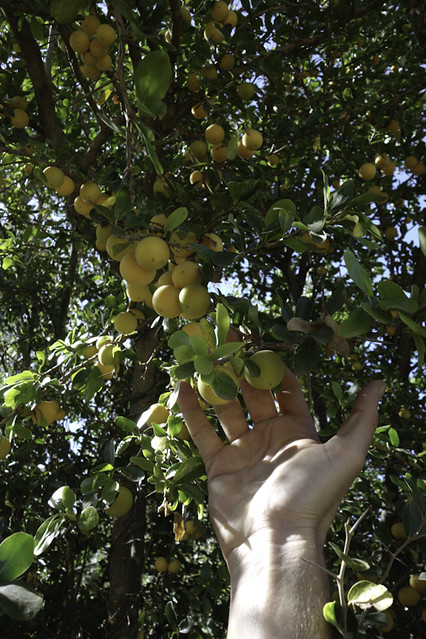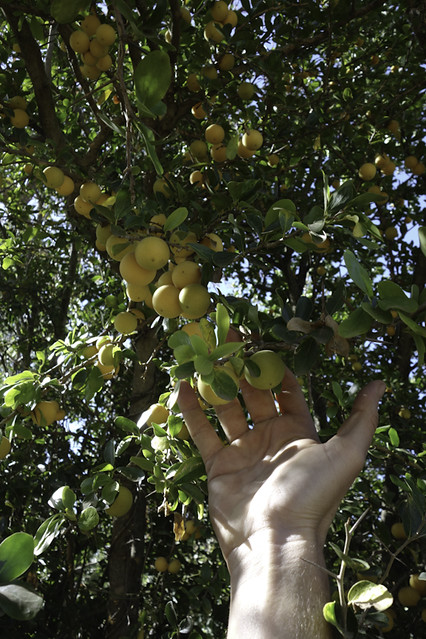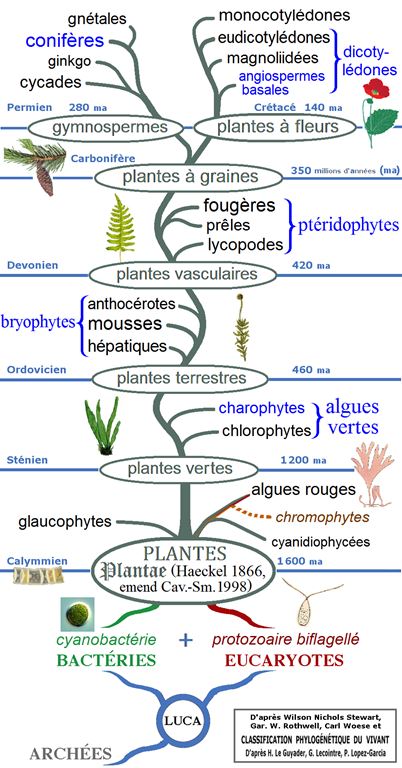Abricotier tropical
(Dovyalis abyssinica)

Un arbuste de taille moyenne. Il atteint 10 m de haut. Il a de nombreuses branches. Le tronc mesure jusqu'à 20 cm d'épaisseur. Les jeunes branches peuvent avoir des épines. ... (traduction automatique)
→suite
Abricotier tropical 
Note alimentaire ![]()
![]()
![]()
![]()
Un arbuste de taille moyenne. Il atteint 10 m de haut. Il a de nombreuses branches. Le tronc mesure jusqu'à 20 cm d'épaisseur. Les jeunes branches peuvent avoir des épines. L'écorce est brun gris. Il existe de nombreuses lenticelles en relief. Les feuilles sont ovales et élancées. Ils mesurent 2,5 à 9 cm de long... (traduction automatique) →suite
Pas d'autre illustration
pour le moment 😕
Classification
- Classique : en haut de l\'écran, sous le coeur.
- Phylogénétique :
- Clade 4 : Angiospermes ;
- Clade 3 : Dicotylédones_vraies ;
- Clade 2 : Rosidées ;
- Clade 1 : Fabidées ;
- Ordre APN : Malpighiales ;
- Famille APN : Salicaceae ;
Illustration : cet arbre phylogénétique des plantes montre les principaux clades et groupes traditionnels (monophylétiques en noir et paraphylétiques en bleu).
Dénominations
✖- Nom botanique : Dovyalis abyssinica (A. Rich.) Warb. (1893)
- Synonymes français : abricot tropical, kashun, = groseille - ou plus précisément/littéralement groseille à maquereau - d'Abyssinie ou abyssinienne (tp* de "Abyssinian-gooseberry"), groseille - ou plus précisément/littéralement groseille à maquereau - d'Afrique ou africaine (tp* de "African-gooseberry")
- Synonymes : Aberia abyssinica (A. Rich.) Hochst, Dovyalis engleri Gilg, Roumea abyssinica A. Rich
- Noms anglais et locaux : dovyalis (Abyssinian), African gooseberry (African-gooseberry), Abyssinian-gooseberry
Description et culture
✖- dont infos de "FOOD PLANTS INTERNATIONAL" :
Description :
Un arbuste de taille moyenne. Il atteint 10 m de haut. Il a de nombreuses branches. Le tronc mesure jusqu'à 20 cm d'épaisseur. Les jeunes branches peuvent avoir des épines. L'écorce est brun gris. Il existe de nombreuses lenticelles en relief. Les feuilles sont ovales et élancées. Ils mesurent 2,5 à 9 cm de long sur 2 à 5 cm de large. Les bords des feuilles peuvent être ondulés ou irréguliers. Les plantes sont séparément mâles et femelles. Les fleurs sont vertes. Les fleurs mâles sont couvertes de poils doux. Ils sont en grappes à l'aisselle des feuilles. Les fleurs femelles se produisent individuellement. Les fruits sont petits et oranges. Ils sont ronds et ont des points pâles. Ils mesurent jusqu'à 2 cm de diamètre. La chair est jaune. Ils sont très acides et ont une forte odeur. Les graines sont peu nombreuses et plates{{{0(+x) (traduction automatique).
Original : A medium sized shrub. It grows up to 10 m tall. It has many branches. The trunk is up to 20 cm thick. Young branches can have spines. The bark is grey brown. There are many raised lenticels. The leaves are oval and slender. They are 2.5-9 cm long by 2-5 cm wide. The edges of the leaves can be wavy or jagged. Plants are separately male and female. Flowers are green. Male flowers are covered in soft hairs. They are in clusters in the axils of leaves. Female flowers occur singly. The fruit are small and orange. They are round and have pale dots. They are up to 2 cm across. The flesh is yellow. They are very acid and have a strong smell. The seeds are few and flat{{{0(+x).
Production :
Il s'écoule 7 à 8 mois entre la floraison et la maturité du fruit. En Tanzanie, les fruits sont récoltés d'avril à juin{{{0(+x) (traduction automatique).
Original : It takes 7-8 months between flowering and fruit maturity. In Tanzania fruit are collected from April to June{{{0(+x).
Culture :
Il peut être cultivé par graines ou boutures. Les fruits sont normalement cueillis sur l'arbre. Les fruits ne se conservent pas bien et se meurtrissent facilement{{{0(+x) (traduction automatique).
Original : It can be grown by seed or cuttings. Fruit are normally picked from the tree. Fruits do not store well and bruise easily{{{0(+x).
 Consommation (rapports de comestibilité, parties utilisables et usages alimentaires correspondants)
Consommation (rapports de comestibilité, parties utilisables et usages alimentaires correspondants)
✖
Fruit0(+x) (fruits27(+x) {pulpe/chair} mûrs{{{(dp*) frais0(+x) crus27(+x) {bruts(dp*) ou confits27(+x)} ou cuits {transformés{{{(dp*)}) comestible0(+x).
Détails : Le fruit est consommé frais et utilisé en confitures, gelées et punchs aux fruits{{{0(+x).
Partie testée :
/| Taux d'humidité | Énergie (kj) | Énergie (kcal) | Protéines (g) |
|---|---|---|---|
| / | / | / | / |
| Pro- vitamines A (µg) |
Vitamines C (mg) | Fer (mg) | Zinc (mg) |
| / | / | / | / |
 Risques et précautions à prendre
Risques et précautions à prendre
✖
néant, inconnus ou indéterminés.
Galerie(s)
✖
Par treesftf, via flickr
Autres infos
✖dont infos de "FOOD PLANTS INTERNATIONAL" :
Statut :
Les fruits sont surtout consommés par les enfants{{{0(+x) (traduction automatique).
Original : The fruit are eaten especially by children{{{0(+x).
Distribution :
Une plante tropicale. Il est originaire d'Afrique du Nord-Est. Les plantes poussent entre 1000 et 3000 m d'altitude en Ethiopie et entre 2000 et 2700 m d'altitude au Kenya. Une pluviométrie comprise entre 1000 et 1700 mm est probablement appropriée. Il convient aux climats chauds et secs. Il pousse mal sur les sols calcaires{{{0(+x) (traduction automatique).
Original : A tropical plant. It is native to NE Africa. Plants grow between 1000 and 3000 m altitude in Ethiopia and between 2000 and 2700 m altitude in Kenya. A rainfall between 1000 and 1700 mm is probably suitable. It suits hot dry climates. It grows poorly on limestone soils{{{0(+x).
Localisation :
Africa, Cuba, East Africa, Eritrea, Ethiopia, Kenya, Malawi, Socotra, Somalia, Tanzania, Uganda, Yemen, Zambia{{{0(+x) (traduction automatique).
Original : Africa, Cuba, East Africa, Eritrea, Ethiopia, Kenya, Malawi, Socotra, Somalia, Tanzania, Uganda, Yemen, Zambia{{{0(+x).
Notes :
Les fruits sont riches en vitamine C. Il existe environ 15 à 22 espèces de Dovyalis. La plupart ont des fruits comestibles. Ils sont principalement en Afrique et au Sri Lanka. Également mis dans la famille Flacourtiaceae{{{0(+x) (traduction automatique).
Original : The fruit are rich in Vitamin C. There are about 15-22 Dovyalis species. Most have edible fruit. They are mostly in Africa and Sri Lanka. Also put in the Flacourtiaceae family{{{0(+x).
Liens, sources et/ou références
✖Sources et/ou références :
Kenya Forestry Research Institute (KFRI, en anglais) ; Traditional Food Plants, pages 254 à 256 (livre en anglais) ; Fruitipedia (en anglais) ; "Dave's Garden" (en anglais) (en anglis) ; Top Tropicals ; 5"Plants For A Future" (en anglais) ;
dont classification : "The Plant List" (en anglais) ; "GRIN" (en anglais) ;
dont livres et bases de données : 0"Food Plants International" (en anglais), 27Dictionnaire des plantes comestibles (livre, page 120, par Louis Bubenicek) ;
dont biographie/références de "FOOD PLANTS INTERNATIONAL" :
Addis, G., et al, 2005, Ethnobotanical Study of Edible Wild Plants in Some Selected Districts of Ethiopia. Human Ecology, Vol. 33, No. 1, pp. 83-118 ; Asfaw, Z. and Tadesse, M., 2001, Prospects for Sustainable Use and Development of Wild Food Plants in Ethiopia. Economic Botany, Vol. 55, No. 1, pp. 47-62 ; Barwick, M., 2004, Tropical and Subtropical Trees. A Worldwide Encyclopedic Guide. Thames and Hudson p 156 ; Bekele-Tesemma A., Birnie, A., & Tengnas, B., 1993, Useful Trees and Shrubs for Ethiopia. Regional Soil Conservation Unit. Technical Handbook No 5. p 200 ; Dale, I. R. and Greenway, P. J., 1961, Kenya Trees and Shrubs. Nairobi. p 224 ; Dharani, N., 2002, Field Guide to common Trees & Shrubs of East Africa. Struik. p 88 ; H. G. A. Engler & K. A. E. Prantl, Nat. Pflanzenfam. 3(6a):44. 1893 ; Ethiopia: Famine Food Field Guide. https://www.africa.upenn.edu/faminefood/category3.htm ; Facciola, S., 1998, Cornucopia 2: a Source Book of Edible Plants. Kampong Publications, p 116 ; FAO, 1988, Traditional Food Plants, FAO Food and Nutrition Paper 42. FAO Rome p 254 ; Fowler, D. G., 2007, Zambian Plants: Their Vernacular Names and Uses. Kew. p 84 ; Glover, 1967, ; Jardin, C., 1970, List of Foods Used In Africa, FAO Nutrition Information Document Series No 2.p 133 ; Johns, T., and Kokwaro, J.O., 1991, Food Plants of the Luo of Siayo District, Kenya. Economic Botany 45(1), pp 103-113 ; Katende, A.B., Birnie, A & Tengnas B., 1995, Useful Trees and Shrubs for Uganda. Identification, Propagation and Management for Agricultural and Pastoral Communities. Technical handbook No 10. Regional Soil Conservation Unit, Nairobi, Kenya. p 246 ; Lovett, J. C. et al, Field Guide to the Moist Forest Trees of Tanzania. p 61 ; Lulekal, E., et al, 2011, Wild edible plants in Ethiopia: a review on their potential to combat food insecurity. Afrika Focus - Vol. 24, No 2. pp 71-121 ; Martin, F. W., et al, 1987, Perennial Edible Fruits of the Tropics. USDA Handbook 642 p 27 ; Maundu, P. et al, 1999, Traditional Food Plants of Kenya. National Museum of Kenya. 288p ; Mengistu, F. & Hager, H., 2008, Wild Edible Fruit Species Cultural Domain, Informant Species Competence and Preference in Three Districts of Amhara Region, Ethiopia. Ethnobotany Research & Applications 6:487-502 ; Msuya, T. S., et al, 2010, Availability, Preference and Consumption of Indigenous Foods in the Eastern Arc Mountains, Tanzania, Ecology of Food and Nutrition, 49:3, 208-227 ; Peters, C. R., O'Brien, E. M., and Drummond, R.B., 1992, Edible Wild plants of Sub-saharan Africa. Kew. p 113 ; White, F., Dowsett-Lemaire, F. and Chapman, J. D., 2001, Evergreen Forest Flora of Malawi. Kew. p 268
Recherche de/pour :
- "Dovyalis abyssinica" sur Google (pages et
images) ;
TROPICOS (en anglais) ;
Tela Botanica ;
Pl@ntNet ;
Pl@ntUse ;
- "Abricotier tropical" sur Google (pages, images et recettes) ;
- "Dovyalis abyssinica" sur Google (pages et
images) ;
TROPICOS (en anglais) ;
Tela Botanica ;
Pl@ntNet ;
Pl@ntUse ;
Espèces du même genre (Dovyalis)
✖19 taxons
- Dovyalis abyssinica (A. Rich.) Warb. (Abricotier tropical)
- Dovyalis abyssinica x Dovyalis hebecarpa
- Dovyalis caffra (Hook. f. & Harv.) Warb. (Pomme de kei)
- Dovyalis glandulosissima
- Dovyalis hebecarpa (Gardner) Warb. (Groseiller de ceylan)
- Dovyalis hispidula
- Dovyalis hybrid
- Dovyalis longispina
- Dovyalis lucida
- Dovyalis macrocalyx
- Dovyalis revoluta
- Dovyalis rhamnoides
- Dovyalis rotundifolia
- Dovyalis verrucosa
- Dovyalis x sp.
- Dovyalis xanthocarpa
- Dovyalis zenkeri
- Dovyalis zeyheri (Sond.) Warb. (Abricotier sauvage)
- Dovyalis ziziphoides
Espèces de la même famille (Salicaceae)
✖50 taxons (sur 182)
- Azara microphylla
- Azara petiolaris
- Banara serrata
- Casearia arborea
- Casearia arguta
- Casearia barteri
- Casearia combaymensis
- Casearia corymbosa Kunth
- Casearia decandra
- Casearia esculenta
- Casearia fasciculata
- Casearia flavovirens
- Casearia fuliginosa
- Casearia glomerata
- Casearia graveolens
- Casearia lasiophylla
- Casearia mexiae
- Casearia nigricans
- Casearia nitida
- Casearia obovalis Poepp. ex Griseb. (Puma muyo)
- Casearia paranaensis
- Casearia pitumba
- Casearia prunifolia
- Casearia rupestris
- Casearia sylvestris
- Casearia tachirensis
- Casearia tomentosa
- Casearia uleana
- Casearia zahlbruckneri
- Casearia zizyphoides
- Dovyalis abyssinica (A. Rich.) Warb. (Abricotier tropical)
- Dovyalis abyssinica x Dovyalis hebecarpa
- Dovyalis caffra (Hook. f. & Harv.) Warb. (Pomme de kei)
- Dovyalis glandulosissima
- Dovyalis hebecarpa (Gardner) Warb. (Groseiller de ceylan)
- Dovyalis hispidula
- Dovyalis hybrid
- Dovyalis longispina
- Dovyalis lucida
- Dovyalis macrocalyx
- Dovyalis revoluta
- Dovyalis rhamnoides
- Dovyalis rotundifolia
- Dovyalis verrucosa
- Dovyalis x sp.
- Dovyalis xanthocarpa
- Dovyalis zenkeri
- Dovyalis zeyheri (Sond.) Warb. (Abricotier sauvage)
- Dovyalis ziziphoides
- Flacourtia euphlebia
- ...


